Eritrean–Ethiopian border conflict
The Eritrean–Ethiopian border conflict was a violent standoff and a proxy conflict between Eritrea and Ethiopia. It consisted of a series of incidents along the then-disputed border; including the Eritrean–Ethiopian War of 1998–2000 and the subsequent Second Afar insurgency. The border conflict was a continuation of the Eritrean–Ethiopian War of 1998–2000. It included multiple clashes with numerous casualties, including the Battle of Tsorona in 2016. Ethiopia stated in 2018 that it would cede Badme to Eritrea. This led to the Eritrea–Ethiopia summit on 9 July 2018, where an agreement was signed which demarcated the border and agreed a resumption of diplomatic relations.[10][11]
| Eritrean–Ethiopian border conflict | |||||||||
|---|---|---|---|---|---|---|---|---|---|
| Part of the Eritrean–Ethiopian War | |||||||||
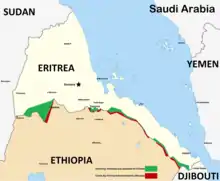 Territory claimed by both sides of the conflict | |||||||||
| |||||||||
| Belligerents | |||||||||
|
Rebel allies TPDM EPPF |
(claimed by Eritrea)[2] | ||||||||
| Commanders and leaders | |||||||||
|
|
| ||||||||
| Strength | |||||||||
|
Unknown rebels |
(1998–2000) Unknown rebels | ||||||||
| Casualties and losses | |||||||||
|
30 Unknown pro-Eritrean rebels killed |
| ||||||||
|
650,000 civilians displaced Total 70,741–98,965+ killed | |||||||||
Background
Colonisation and border conflict
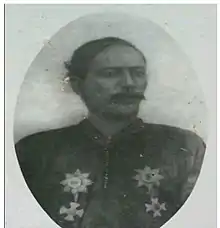
In March 1870, an Italian shipping company become a claimant to the territory at the northern end of Assab Bay, a deserted but spacious bay about half-way between Annesley Bay to the north and Obock to the south.[12] The area —which had long been dominated by the Ottoman Empire and Egypt [13] was not settled by the Italians until 1880.[14] In 1884, the Hewett Treaty was signed between the British Empire and Ethiopia, reigned by Emperor Yohannes IV (r. 1871–1889). The British Empire promised the highlands of modern Eritrea—and free access to the Massawan coast to Ethiopia in exchange for its help evacuating garrisons from the Sudan, in the then-ongoing Mahdist War.[15] In 1889, the disorder that followed the death of Yohannes IV, Italian General Oreste Baratieri occupied the highlands along the Eritrean coast and Italy proclaimed the establishment of a new colony of "Eritrea", (from the Latin name for the Red Sea), with its capital at Asmara in substitution foe Massawa.[16] On 2 May 1889, the peace and friendship Treaty of Wuchale was signed between Italy and Ethiopia, under which Italian Eritrea was officially recognised by Ethiopia as part of Italy.[17]
However, Article 17 of the treaty was disputed as the Italian version stated that Ethiopia was obliged to conduct all foreign affairs through Italian authorities, in effect making Ethiopia an Italian protectorate, while the Amharic version gave Ethiopia considerable autonomy, with the option of communicating with third powers through the Italians.[18][19][20] This resulted in the First Italo-Ethiopian War,[21] which the Ethiopians won, resulting in the Treaty of Addis Ababa in October 1896. Italy paid reparations of ten million Italian lira. Unusually, the Italians retained most, if not all, of the territories beyond the Mareb-Belessa and May/Muni rivers that they had taken; Emperor Menelik II (r. 1889–1913) gave away part of Tigray which had been treated as Ethiopian since time immemorial.[22][23] On 2 August 1928, Ethiopia and Italy signed a new friendship treaty.[24]
Ethiopia under Italian rule
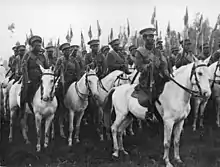
On 22 November 1934, Italy claimed that three senior Ethiopian military-political commanders with a force of 1,000 Ethiopian militia arrived near Walwal and formally requested the garrison stationed there, comprising about 60 Somali soldiers, known as dubats, to withdraw.[25] The Somali NCO leading the garrison refused and alerted Captain Cimmaruta, commander of the garrison of Uarder, 20 kilometres (12 mi) away, what had happened.[26]
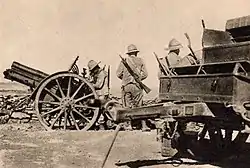
Between 5 and 7 December 1934, for reasons which have never been clearly determined, a skirmish broke out between the garrison and the Ethiopian militia. According to the Italians, the Ethiopians attacked the Somalis with rifle and machine-gun fire.[27] According to the Ethiopians, the Italians attacked them, supported by two tanks and three aircraft.[28] According to historian Anthony Mockler 107 Ethiopians were killed.[29] By 3 October 1935, the Italian Army led by General Emilio De Bono launched an invasion of Ethiopia, without a declaration of war. This was the start of a new war called the Second Italo-Ethiopian War.[30] In May 1936, the Italian Army occupied the Ethiopian capital Addis Ababa.[31] The occupied country was annexed into the Italian East African colony together with the other Italian east African colonies.[32]
On 10 June 1940, Italy declared war on Britain and France;[33] in March 1941 Britain began a campaign to capture the Italian-held territory in the region.[34] By November, the British had occupied the whole Italian East African colony. However thousands of Italian soldiers began conducting a guerrilla war within their former colony[35] which lasted until October 1943.[36] After the end of WWII, Ethiopia regained her independence, and Eritrea was placed under Britain military administration.[37]
Prelude
Eritrea as part of Ethiopia
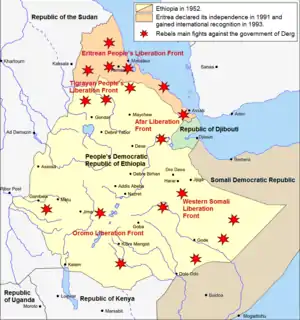
After the war there was a debate as to what would happen to Eritrea. After the Italian communists' victory in the 1946 Italian general election they supported returning Eritrea to Italy under a trusteeship or as a colony. The Soviet Union similarly wished to make it their trustee; and tried to achieve this by diplomatic means, but they failed.[38][39]
Ethiopian Emperor Haile Selassie I (r. 1930–1974) also claimed Eritrea. In 1952 the United Nations decided that Eritrea would become part of the Ethiopian Empire. Eritrea became a special autonomous region within a federated Eithiopia.[40]
In 1958, a group of Eritreans founded the Eritrean Liberation Front (ELF). The organisation mainly consisted of Eritrean students, professionals and intellectuals. It engaged in clandestine political activities intended to cultivate resistance to the centralising policies of the imperial Ethiopian state.[41] During the following decade the Emperor decided to dissolve the federation between Ethiopia and Eritrea, annexing the special region and bringing it under direct rule.[40]
This resulted in an almost thirty-year long armed struggle known as the Eritrean War of Independence.[42][40] The ELF engaged in armed conflict against the Ethiopian Government from 1 September 1961. In 1970 a group called the Eritrean People's Liberation Front (EPLF) broke off from the ELF.[43] They were fierce rivals and in February 1972, the First Eritrean Civil War broke out between them.[44] Their rivalry paused in 1974, and calls for the conflict to stop were finally heeded. These calls for peace came from local villagers at a time when the independence movement was close to victory over Ethiopia.[44] On 12 September 1974, a successful coup d'état was carried out against the Emperor led by Lieutenant General Aman Andom. The government was led by members of the pro-Soviet Ethiopian military, which established an almost seven-year long military junta.[45]
The ELF-EPLF's peace lasted only six years; in February 1980 the EPLF declared war on the ELF, after which the ELF and the Soviet Union started secret negotiations. The Second Eritrean Civil War lasted until 1981, and the EPLF emerged victorious, with help from the Tigray People's Liberation Front (TPLF). The ELF was driven out of Eritrea into Sudan.[46] On 27 May 1991 the new Ethiopian Transitional Government was formed after the fall of the pro-Soviet government. The Ethiopian Transitional Government promised to hold a referendum, within two years in the region. The referendum was held between 23–25 April 1993 with 99.81% voting in favour of independence. On 4 May 1993 the official independence of Eritrea was established.[47] However, the border between Ethiopia and newly independent Eritrea was not clearly defined. After border skirmishes in late 1997, the two countries attempted to negotiate their boundary.[48] In October 1997, Ethiopia presented the Eritrean Government a map showing Eritrean-claimed areas as part of Ethiopia.[49]
History
War era
On 8 May 1998, border clashes erupted between Ethiopia and Eritrea, killing several Eritrean officials near the then-disputed town of Badme.[50][51] A large Eritrean mechanised force entered the town, and a firefight broke out between the Eritrean soldiers and the Tigrayan militia and security police they encountered.[50][52][note 1]
On 13 May, Eritrean radio described the incidents as a "total war" policy from Ethiopia, and claimed that the Ethiopian Army was mobilising for a full assault against Eritrea.[54] The organisation Claims Commission found that this was in essence an affirmation of the existence of a state of war between belligerents, not a declaration of war, and that Ethiopia also notified the United Nations Security Council, as required under Article 51 of the UN Charter.[55] On 1 March 1999 Ethiopia declares victory over Eritea by recapturing the Badme region on the Eritea side it denies its defeat. By the time Ethiopian forces had broken through Eritrea's fortified front and was 10 kilometres (6.2 mi) deep into Eritrean territory, Eritrea accepted the Organisation of African Unity (OAU) peace plan on 27 February 1999.[56][57] The "proximity talks" broke down in early May 2000 "with Ethiopia accusing Eritrea of imposing unacceptable conditions".[58][59] On 12 May the Ethiopians launched an offensive that broke through the Eritrean lines between Shambuko and Mendefera, crossed the Mareb River, and cut the road between Barentu and Mendefera, the main supply line for Eritrean troops on the western front of the fighting.[60][61] Ethiopia declared the war was over at 25 May 2000.[62] At the end of May 2000, Ethiopia occupied about a quarter of Eritrea's territory.[63]
Conflict on the border
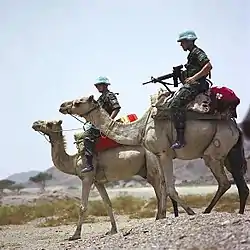
After a cease-fire was established on 18 June 2000, both parties agreed to have a 25-kilometre-wide (16 mi) demilitarised zone called the Temporary Security Zone (TSZ). It was patrolled by the United Nations Mission in Ethiopia and Eritrea (UNMEE) an organisation for the border stabilisation and the prevention of future conflicts between the countries. On 31 July 2000, the UNMEE was officially launched and started patrolling the border.[64] On 12 December 2000, a peace agreement was signed in Algiers.[65] In August 2002 Eritrea released all the Ethiopian POWs.[66]
In September 2007, Kjell Bondevik, a United Nations' official, warned that the border conflict could cause a new war.[67] On 16 January 2008, the Eritrean Government give up all of its claims in Ethiopia.[68] In February, the UNMEE commenced pulling its peacekeepers out of Eritrea due to Eritrean Government restrictions on its fuel supplies.[67] On 30 July 2008, the Security Council held a vote which ended the UN mission the next day.[69] In June 2009 a rebel group called Democratic Movement for the Liberation of the Eritrean Kunama (DMLEK) joined the fight against the Eritrean Government with the pro-Ethiopian Red Sea Afar Democratic Organisation (RSADO).[5] On 23 April 2010, RSADO and the Eritrean National Salvation Front (ENSF) attacked an Eritrean Army's base, they also took it over for 3 hours until 6 a.m. They killed At least 11 Eriteans soldiers and wounded more than 20 others.[70]
The conflict deepened in March 2012, when Ethiopia launched an offensive into Eritrean-held territory. Three Eritrean military camps were attacked, and a number of people were killed or captured.[67][71] Several weeks prior to the offensive, Ethiopia blamed Eritrea for supporting the Ethiopian rebels who had staged the Afar region tourist attack in northern Eithiopia, in which five Western tourists were killed.[67] On 7 September 2013, two Ethiopian-supported Eritrean rebel groups RSADO and the Saho People's Democratic Movement (SPDM) agreed to fight together against the Eritrean Government.[72] In December 2013 the Ethiopian Army, crossed the border to attack some rebel camps in Eritrea.[73]
In June 2016, Eritrea claimed that 200 Ethiopian soldiers were killed and 300 wounded in a battle at Tsorona.[42] On 22 June 2016 Eritrea warned the UN Human Rights Council that a new war between Ethiopia and the country can restart as Ethiopia was planning for a new attack.[73] On 2 April 2018 former Ethiopian Prime Minister Hailemariam Desalegn resigned due to the unrest and a new Ethiopian Prime Minister, Abiy Ahmed, was appointed.[74] On 5 June 2018 Ahmed announced that Ethiopia relinquished its claims on the disputed areas and that the conflict with Eritrea was at an end.[75] He arrived on 8 July 2018 in Asmara, Eritrea. Where his counterpart, President Isaias Afwerki, greeted him at Asmara International Airport.[76] The next day both leaders signed a five-point Joint Declaration of Peace and Friendship, which declared that "the state of war between Ethiopia and Eritrea has come to an end; a new era of peace and friendship has been opened" and ceded Badme to Eritrea.[77]
Proxy conflict
Since the cease-fire was established both countries claimed to backing each other's rebels.[78] In 2006 the Ethiopian Government deployed its forces in its neighbour country Somalia, backing the government by fighting against the Islamists. The Ethiopian and Somali governments, accuses Eritrea for backing the Islamists in the region, in reaction of the Somali Government it started backing the Eritrean rebels.[79][80] In April 2007 Ethiopia accuses also Eritrea for supporting the rebel groups like the Ogaden National Liberation Front (ONLF) and the Afar Revolutionary Democratic Unity Front (ARDUF).[79] In April 2011 Ethiopia openly declared its support for Eritrean rebel groups.[67] According to the Global Security in 2014 the rebel group Tigray People’s Democratic Movement ([TPDM] which is active in the Tigray Region) was the most important rebel group in Eritrea fighting against the Ethiopian Government, Eritrea also financed and train the group.[81]
In January 2015, the pro-Eritrean rebel groups, the Ginbot 7 and the Ethiopian People's Patriotic Front (EPPF) merged to fight against the Ethiopian Government, and called itself the Arbegnoch – Ginbot 7 for Unity and Democracy Movement (AGUDM).[82] On 25 July 2015, Ginbot 7 decided to go in an armed resistance and goes into exile in Eritea.[83] On 10 October 2016, the Ethiopian Government claimed that Eritrea (was also helping Oromo Liberation Front [OLF])[84] and Egypt were behind the Oromo protests in Ethiopia.[85]
Aftermath
After the Eritrea–Ethiopia peace summit, Ethiopian Prime Minister Ahmed requested that United Nations Secretary-General António Guterres lift the United Nations' sanctions on Eritrea, imposed largely due to the efforts of Ethiopian diplomacy.[86] Ethiopian Airlines announced that it would resume flights to Asmara on 16 July.[87] Between 14–16 July President Isaias visited Ethiopia and its president, Mulatu Teshome. Isaias affirmed the unity of Eritrea and Ethiopia, saying "henceforth, anyone who says Eritreans and Ethiopians are two different peoples is one that doesn't know the truth".[88] He visited an industrial park in Awasa and presided over the reopening of the Eritrean Embassy.[89] On 6 September, the Ethiopian Embassy was reopened in the Eritrean capital Asmara.[90] On 11 September, for the first time in twenty years, Eritrea–Ethiopia border crossings were reopened at Serha–Zalambesa and Debaysima–Burre.[91] Five days later, both leaders signed a new peace agreement in Jeddah, Saudi Arabia.[92] Soon after the peace summit many Ethiopian rebels returned to Ethiopia including TPDM, OLF and Ginbot 7 all those groups were demobilised and unbanded as terrorists. On 10 October, the last 2,000 of TPDM members returned to Ethiopia.[93] The UN lifted its sanctions on 14 November 2018 after nine years against Eritrea. Eritrea made also a joint agreement with Somalia and Ethiopia to co-operate with each other.[94] Later on 13 December 2018 President Afwerki went to Somalia for the first time in two decades.[95]
During only the war, between 70,000 and 150,000 people were killed and 650,000 displaced,[42][96][63] of whom 19,000 were Eritrean soldiers[97] and between 80,000 - 123,000 were Ethiopian soldiers.[98] The casualties after the war there were between 523–530 dead in the Second Afar insurgency alone. On the Eritrean side the casualties of the conflict were between 427–434 Eritreans killed, 30 pro-Eritrean rebels killed, 88 Eritrean soldiers wounded and 2 Eritreans captured. The Ethiopian side were 49 Ethiopian soldiers (claimed by rebels), and five civilians were killed, also, 23 civilians were kidnapped and three others were wounded.[99][100][101][102][70][103][104][105][106][107][108][109] On the both countries border, the casualties of both countries were according to Eritrea at least 18 Eritreans and over 200 Ethiopians.[110]
See also
References
Notes
- The Eritreans describe the start of the war thus: "after a series of armed incidents during which several Eritrean officials were murdered near the disputed village of Badme, Ethiopia declared total war as on 13 May and mobilised its armed forces for a full-scale assault on Eritrea."[53]
Citations
- "REPORTS OF OPPOSITION ATTACKS AND BORDER SKIRMISH WITH ETHIOPIA". Wikileaks. 5 January 2010. Retrieved 8 December 2018.
- "Eritrea accuses Sudan and Ethiopia of conspiracy". The EastAfrican. 16 May 2018. Retrieved 30 December 2018.
- "BBC Monitoring Alert - ETHIOPIA". Wikileaks. 3 May 2010. Retrieved 8 December 2018.
- Shinn 2004, pp. 387–388.
- "Opposition Group Promises Attacks Following Sanctions on Eritrea for Support of Terrorism". The Jamestown. 7 January 2010. Retrieved 8 December 2018.
- "In Eritrea, youth frustrated by long service". The Mail Guardian. 18 July 2008. Archived from the original on 22 November 2018. Retrieved 21 November 2018.
- "Ethiopian Army". Global Security. Archived from the original on 22 November 2018. Retrieved 21 November 2018.
- "Ethiopia – Armed forces". Nations Encyclopedia. Archived from the original on 22 November 2018. Retrieved 21 November 2018.
- "Ethiopia Military Strength". Global Firepower. Archived from the original on 19 October 2018. Retrieved 21 November 2018.
- "Ethiopia, Eritrea officially end war". Deutsche Welle. Archived from the original on 9 July 2018. Retrieved 9 July 2018.
- "Ethiopia's Abiy and Eritrea's Afewerki declare end of war". BBC News. 9 July 2018. Archived from the original on 9 July 2018. Retrieved 9 July 2018.
- Ramm 1944, pp. 214–215.
- . Encyclopædia Britannica. 09 (11th ed.). 1911.
- Masi & Kretz 1911, p. 747.
- Modern Abyssinia. Methuen & Company. Retrieved 20 November 2018.
- "Asmara italiana". 6 August 2018. Archived from the original on 17 September 2018. Retrieved 25 September 2018.
- "Treaty of Wuchale" (PDF). African Legends. Retrieved 11 October 2018.
- Prouty 1986, pp. 70–99.
- Marcus 1995, pp. 111–134.
- Elliesie 2008, pp. 235–244.
- Prouty 1986, p. 143.
- Perham 1948, p. 58.
- Marcus 1995, p. 175.
- Marcus 2002, p. 126.
- Quirico 2002, p. 267.
- Quirico 2002, p. 271.
- Quirico 2002, p. 272.
- Barker 2002, p. 17.
- Mockler 2003, p. 31.
- Barker 2002, p. 33.
- "Ethiopia 1935–36: mustard gas and attacks on the Red Cross". International Committee of the Red Cross. 13 August 2003. Archived from the original on 1 December 2006. Retrieved 18 October 2018.
- "Ethiopia – Italian East Africa". World States Men. Archived from the original on 12 February 2012. Retrieved 18 October 2018.
- Playfair 1954, pp. 6–7.
- Rohwer & Hümmelchen 1992, p. 54.
- "How Italy Was Defeated In East Africa In 1941". Imperial War Museums. 18 June 2018. Archived from the original on 19 October 2018. Retrieved 18 October 2018.
- Cernuschi 1994, p. 5.
- Zolber, Aguayo & Suhrke 1992, p. 106.
- Mastny 1996, pp. 23–24.
- "The Big Three After World War II: New Documents on Soviet Thinking about Post-War Relations with the United States and Great Britain" (PDF). Woodrow Wilson International Center for Scholars. 13 May 1995. pp. 19–21. Archived (PDF) from the original on 6 July 2017. Retrieved 29 November 2018.
- "Ethiopia and Eritrea". Global Policy Forum. Archived from the original on 19 May 2016. Retrieved 25 October 2018.
- "Ethiopia : a country study". Kessinger Publishing. 1993. p. 69. Retrieved 30 November 2018.
- "Eritrea Says It Killed 200 Ethiopian Troops in Border Clash". Bloomberg. 16 June 2016. Archived from the original on 13 October 2017. Retrieved 9 July 2018.
- "Eritrean People's Liberation Front". Encyclopaedia Britannica. Archived from the original on 4 November 2018. Retrieved 1 November 2018.
- "Eritrea: A Small War in Africa Volume 10 – Issue 7". Dehai. 1998. Archived from the original on 1 May 2007. Retrieved 1 November 2018.
- Wrong 2005, p. 244.
- Connell and Killion 2010, p. 38.
- "Eritrea Birth of a Nation". Dehai. 1993. Archived from the original on 30 October 2017. Retrieved 18 November 2018.
- Briggs & Blatt 2009, pp. 28–29.
- "Eritrea - Ethiopia Relations". Global Security. 10 July 2018. Retrieved 26 November 2018.
- "Eritrea/Ethiopia War Looms". Foreign Policy in Focus. 2 October 2005. Retrieved 13 September 2018.
- "Border conflict with Ethiopia". Eritrea. Archived from the original on 16 April 2018. Retrieved 13 September 2018.
- "There are no winners in this insane and destructive war". The Independent. 2 June 2000. Archived from the original on 12 December 2008. Retrieved 13 September 2018.
- "history". Embassy of the State of Eritrea, New Delhi, India. Archived from the original on 9 February 2015. Retrieved 13 September 2018.
- "World: Africa Eritrea: 'Ethiopia pursues total war'". BBC News. 6 June 1998. Retrieved 13 September 2018.
- "A commentary on Eritrea Ethiopia Claims Commission findings". From Peace to Justice. 31 March 2006. Archived from the original on 9 October 2007. Retrieved 13 September 2018.
- "Ethiopia declares victory". BBC News. 1 March 1999. Retrieved 4 December 2018.
- "Eritrea accepts peace deal after Ethiopian incursion". CNN. 27 February 1999. Retrieved 4 December 2018.
- "Diplomats fail to bridge the gap". BBC News. 12 May 2000. Retrieved 8 December 2018.
- "Ethiopia says war nearly over". BBC News. 23 May 2000. Retrieved 8 December 2018.
- "Ethiopia's war strategy". BBC News. 19 May 2000. Retrieved 8 December 2018.
- "The Ethiopia-Eritrea Conflict: A Fragile Peace". African Security Review. 2000. Archived from the original on 5 March 2012. Retrieved 5 December 2018.
- "Ethiopia declares victory over Eritrea". The Guardian Unlimited. 25 May 2000. Retrieved 8 December 2018.
- "Eritrean, Ethiopian exchange of POWs begins". CNN. 23 December 2000. Retrieved 8 December 2018.
- United Nations Security Council Resolution 1312. S/RES/1312(2000) 2000-07-31.
- "Peace Agreements Digital Collection" (PDF). United States Institute of Peace. 12 December 2000. Archived (PDF) from the original on 3 August 2018. Retrieved 13 September 2018.
- "THE WAR REPORT 2018: THE ERITREA–ETHIOPIA ARMED CONFLICT" (PDF). Geneva Academy. Retrieved 30 December 2018.
- "Ethiopia 'launches military attack inside Eritrea'". BBC News. 15 March 2012. Archived from the original on 19 July 2018. Retrieved 9 July 2018.
- "Eritrea accepts 'virtual' border with Ethiopia". ABC News. 16 January 2008. Archived from the original on 6 April 2017. Retrieved 23 September 2018.
- "Security Council ends UN monitoring of Eritrea-Ethiopia row". 30 July 2008. Archived from the original on 20 May 2011. Retrieved 23 September 2018.
- "Eritrean rebels claim killing 11 government soldiers". Reuters. 23 April 2010. Retrieved 4 December 2018.
- "'Significant' casualties in Eritrea and Ethiopia border battle". News24. 13 June 2016. Retrieved 8 December 2018.
- "Exiled Eritrean rebel groups plan joint military attack against regime". Sudan Tribune. 7 September 2013. Retrieved 30 November 2018.
- "Border war with Ethiopia (1998-2000)". Global Security. Retrieved 4 December 2018.
- "Four questions about the Ethiopian PM's resignation". The Daily Monitor. 16 February 2018. Archived from the original on 9 July 2018. Retrieved 20 November 2018.
- "UPDATE 3-Ethiopia opens up telecoms, airline to private, foreign investors". Reuters. 5 June 2018. Archived from the original on 26 August 2018. Retrieved 20 November 2018.
- "Ethiopia's PM Abiy Ahmed in Eritrea for landmark visit". al-Jazeera English. 8 July 2018. Archived from the original on 9 July 2018. Retrieved 9 July 2018.
- "Ethiopia, Eritrea sign statement declaring end of war". France 24. 9 July 2018. Archived from the original on 9 July 2018. Retrieved 9 July 2018.
- "Battle Breaks Out on Ethiopia-Eritrea Border". U.S. News. 10 July 2015. Retrieved 2 December 2018.
- "Eritrea hosts regional rebels". Wikileaks. 17 June 2013. Retrieved 30 November 2018.
- "Ethiopia troops head for Baidoa". BBC News. 20 August 2006. Retrieved 2 December 2018.
- "Tigray People's Democratic Movement". Global Security. Retrieved 3 December 2018.
- "Eritrea cranks' out yet another phantom Ethiopian rebel group made in Eritrea". Tigrai Online. 11 January 2015. Retrieved 3 December 2018.
- "Ethiopian opposition leader, Berhanu Nega, 'moves armed operation to Eritrea'". Martinplaut. 25 July 2015. Retrieved 3 December 2018.
- "Ethiopia claims Eritrea behind Oromo protests but activists warn against 'state propaganda'". International Business Time. 26 February 2018. Retrieved 30 November 2018.
- "Ethiopia blames Egypt and Eritrea over unrest". BBC News. 16 October 2016. Archived from the original on 4 July 2018. Retrieved 13 September 2018.
- "Ethiopia and Eritrea Declare an End to Their War". The New York Times. 9 July 2018. Archived from the original on 14 September 2018. Retrieved 19 September 2018.
- "Ethiopian to resume flights to Asmara next week". Fana News. 9 July 2018. Archived from the original on 10 July 2018. Retrieved 19 September 2018.
- "State Lunch in honor of President Isaias". Shabait. 15 July 2018. Archived from the original on 16 July 2018. Retrieved 19 September 2018.
- "At concert, Ethiopia, Eritrea leaders preach peace, love, unity". Reuters. 15 July 2018. Archived from the original on 18 August 2018. Retrieved 19 September 2018.
- "Ethiopia reopens embassy in Eritrea amid thaw in ties". al-Jazeera. 6 September 2018. Archived from the original on 19 September 2018. Retrieved 19 September 2018.
- "Ethiopia-Eritrea Border Opens for First Time in 20 Years". The New York Times. 11 September 2018. Archived from the original on 16 September 2018. Retrieved 19 September 2018.
- "Ethiopian, Eritrean leaders sign peace agreement in Jeddah". Reuters. 16 September 2018. Archived from the original on 18 September 2018. Retrieved 19 September 2018.
- "About 2,000 Tigray rebels return to Ethiopia from Eritrea". Africa News. 10 October 2018. Retrieved 3 December 2018.
- "Eritrea breakthrough as UN sanctions lifted". BBC News. 14 November 2018. Retrieved 30 December 2018.
- "Somalia: Eritrean leader in 'historic' visit to Somalia". BBC News. 13 December 2018. Retrieved 30 December 2018.
- "Government of Eritrea – Government of Ethiopia". Uppsala Conflict Data Program. Archived from the original on 1 October 2017. Retrieved 19 September 2018.
- "Eritrea reveals human cost of war". BBC News. 20 June 2001. Archived from the original on 12 July 2018. Retrieved 20 November 2018.
- Ofcansky & Shinn 2013, p. 149.
- "Woyanne-backed rebels claim killing 285 Eritrean soldiers". Ethiopian Review. 17 November 2008. Retrieved 4 December 2018.
- "Red Sea Afar rebels attack Eritrean military camp". Sudan Tribune. 26 January 2006. Retrieved 4 December 2018.
- "REPORTS OF OPPOSITION ATTACKS AND BORDER SKIRMISH WITH ETHIOPIA". Wikileaks. 5 January 2010. Retrieved 4 December 2018. Cite journal requires
|journal=(help) - "Eritrean Rebels Say Kill 25 Government Troops In Attacks". Nazret. 2 January 2010. Retrieved 4 December 2018.
- "Eritrea profile - Timeline". BBC News. 18 January 2012. Retrieved 4 December 2018.
- "Eritrean rebels 'kill 12 government troops'". Sudan Tribune. 22 October 2011. Retrieved 4 December 2018.
- "Eritrea rebels say killed 17 soldiers in raid". Reuters. 1 December 2011. Retrieved 4 December 2018.
- "Ethiopia: Tourists kidnapped after deadly Afar attack". BBC News. 18 January 2012. Retrieved 4 December 2018.
- "Ethiopia says four kidnapped in Afar tourist attack". Reuters. 18 January 2012. Archived from the original on 18 February 2013. Retrieved 4 December 2018.
- "Eritrean rebels kill 7 intelligence agents". Sudan Tribune. 22 December 2014. Retrieved 4 December 2018.
- "Battle Breaks Out on Ethiopia-Eritrea Border". U.S. News. 10 July 2015. Retrieved 5 August 2018.
- "Commemoration of Martyrs Day". Shabait. Retrieved 8 December 2018.
Bibliography
- Abbink, Jon; De Bruijn, Mirjam; Van Walraven, Klass, eds. (2003). Rethinking Resistance: Revolt and Violence in African History. BRILL. ISBN 9789004126244.
- Abbink, Jon 2009, Law against reality? Contextualizing the Ethiopian-Eritrean border problem.'In: Andrea de Guttry, Harry Post & Gabriella Venturini, eds., The 1998–2000 War Between Eritrea and Ethiopia: An International Legal Perspective, pp. 141–158. The Hague: T.M.C. Asser Press – Cambridge: Cambridge University Press.
- Abbink, Jon 1998, Briefing: The Eritrean-Ethiopian border dispute. African Affairs 97(389): 551–565.
- Barker, A. J. (1971). Rape of Ethiopia, 1936. Ballantine Books. ISBN 9780345024626.
- Briggs, Philip; Blatt, Brian (2009). Ethiopia. Bradt Guides (5, illustrated ed.). Bradt Travel Guides. ISBN 978-1-84162-284-2.
- Chisholm, Hugh, ed. (1911). . Encyclopædia Britannica. 09 (11th ed.). Cambridge University Press. pp. 745–748.
- Connell, Dan; Killion, Tom (2010). Historical Dictionary of Eritrea – Volume 114 van Historical Dictionaries of Africa. Scarecrow Press. ISBN 9780810875050.
- Elliesie, Hatem (2008). "Amharisch als diplomatische Sprache im Völkervertragsrecht, Aethiopica (International Journal of Ethiopian and Eritrean Studies)" [Amharic as a diplomatic language in international contract law]. Aethiopica (in German). Wiesbaden.
- Griffith, Francis L.; and seven others (1911). . In Chisholm, Hugh (ed.). Encyclopædia Britannica. 09 (11th ed.). Cambridge University Press. pp. 80–130.
- Marcus, Harold G. (1995). The life and times of Menelik II: Ethiopia, 1844–1913. Red Sea Press. ISBN 9781569020098.
- Marcus, Harold G. (2002). A History of Ethiopia. University of California Press. ISBN 9780520925427.
- Mastny, Vojtech (1996). The Cold War and Soviet Insecurity: The Stalin Years. Oxford University Press. ISBN 978-0195352115.
- Mockler, Anthony (2003). Haile Selassie's War. Signal Books. ISBN 9781902669533.
- Perham, Margery (1948). The government of Ethiopia. Faber and Faber. OCLC 641422648.
- Prouty, Chris (1986). Empress Taytu and Menilek II: Ethiopia, 1883–1910. Ravens Educational & Development Services. ISBN 9780932415103.
- Quirico, Domenico (2002). Lo Squadrons Bianco [The Squadrons White] (in Italian). Mondadori. ISBN 9788804506911.
- Ramm, Agatha (1944). "Great Britain and the Planting of Italian Power in the Red Sea, 1868–1885 – The English Historical Review Vol. 59 – No. 234". The English Historical Review. Oxford University Press: 211–236. doi:10.1093/ehr/LIX.CCXXXIV.211. JSTOR 554002.
- Shinn, David H.; Ofcansky, Thomas P. (2013). Historical Dictionary of Ethiopia. Scarecrow Press. ISBN 978-0810874572.
.svg.png.webp)